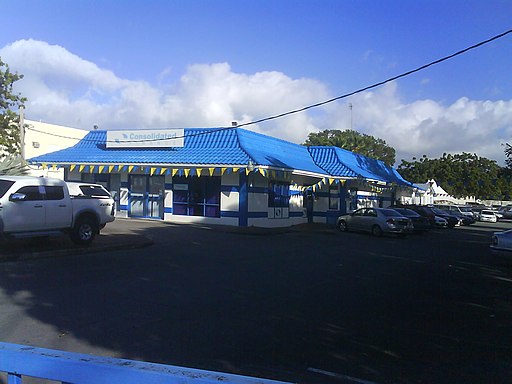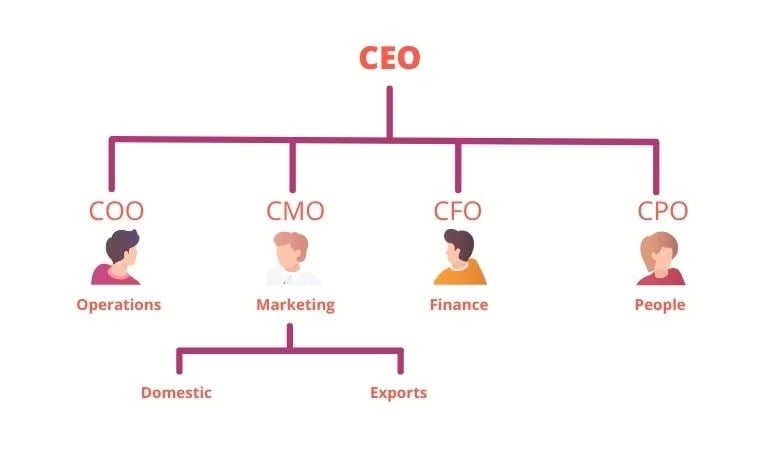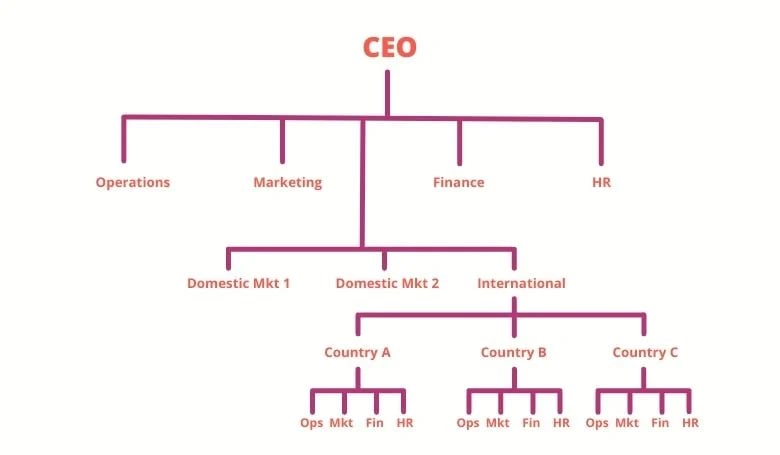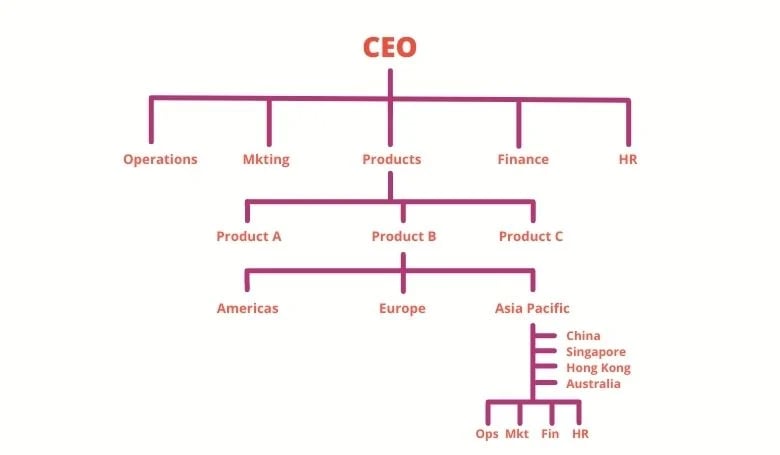Key Takeaways:
Organizations face increasing complexity in the international market, and must handle country-specific market differences, cultures, and staffing for effective international operations.
- The term 'international organization' refers to companies operating across multiple national borders, distinct from 'intergovernmental organizations' like the UN or WHO.
- A well-structured organization is critical for successful international operations, yet many struggle with clear accountabilities.
- Global companies may face challenges with standardization.
- International organizational structures can begin with a functional structure, evolving into international divisions and eventually to a global functional organization. • Advantages of a global functional organization include specialization, centralized control, and opportunities for advancement, while disadvantages involve coordination challenges and cultural differences.
- Alternative structures like global product organizations focus on product departments but can lead to replication of tasks and less strategic focus.
In these days of globalized business, organizations are faced with international competitors in their domestic markets, as well as competitive forces when operating abroad. A successful organization should define its current structure while envisioning future needs, especially for international growth.
Being able to handle country-specific market differences, cultures and staff is going to be critical if a company’s international operations are to be effective.
In this article, when we use the term ‘international organization’ we are referring to a company operating across multiple national borders, as distinct from an ‘international institution’.
Confusingly, the latter can also be known as an international organization, but is better described as an 'intergovernmental organization'. These are set up to establish a common set of rules between countries. Examples include the United Nations, the World Health Organization, OECD, INTERPOL and NATO.
So, we are not talking about the UN or the WHO here, we are talking about companies that have broad international operations, selling products and services across multiple countries.
Going International is Not Easy
The way a company organizes itself can have dramatic effects on its overall performance, and getting this piece right when going international is critically important.
Sadly, it is not usually done well. In a recent McKinsey survey of more than 300 executives, only 44% said they felt their organizational structure created clear accountabilities. (1)
“Global companies find structure difficult because there are no simple solutions,” said the McKinsey report, “Most global structural options create challenges as well as benefits.”
For example, many international organizations have strong, set rules laid down for how their products and services should be branded, sold and distributed across the world.
A McDonald’s Big Mac is the same Big Mac wherever it is bought, the world over. However, some global companies are finding problems with this approach, with the standardization producing limitations on certain markets, reducing the ability to respond to local customer needs.
Despite being a global franchise brand, McDonald’s has not gone down well in the Caribbean. Despite opening 11 outlets in Jamaica in the mid-1990's, the last store closed in 2005.
Reasons included a sluggish economy and the relative high cost price of the franchise and its training requirements. Fundamentally though, it was the product itself. The locals felt the burgers and meals were not big enough to quench the appetite, and tasted bland. Even an attempt to introduce a local Jamaican 'jerk chicken burger' with spicy sauce fell flat.
In Barbados, the Golden Arches only lasted one year; and they pulled out of Trinidad and Tobago altogether in 2003.

Look familiar? A former McDonald's outlet in Barbados now houses a finance company. Photo by CaribDigita, Public domain, via Wikimedia Commons
Functional International Organizational Structure
When a company commences international operations, it might start by exporting to those markets from a home base.
Assuming the company organizes itself in a traditional functional sense, then these exports may be covered by the sales department, possibly with an additional department to the domestic market sales:
International Exports Structure

The exports department might be headed up by a VP of International Sales or a Manager of Exports.
As the foreign operations grow, you might see a change in organizational structure, with a whole international division being created. A Head of the International Division may have several country line managers reporting to them, with each subsidiary country having its own operations, finance, marketing and sales departments within in:
International Divisional Structure

The final stage of internationalization will be when the organization is operating across the world, on several continents (America, Europe and Asia, for example), and moves to a global divisional structure, also by function.
Here, the company may best be described as a Multinational Corporation (MNC), with the independence of decision-making driven down to the country-specific level, albeit across the top of an overall organizational mission for the entire company.
Advantages of Global Functional Organization
- Specialization of functional expertise at country level
- Centralized control at global headquarters
- International focus at top management level
- Plenty of opportunity for progression within company
- Strong breeding ground for future CEOs, from among country Heads
Disadvantages of Global Functional Organization
- Difficulties in managing cross-country coordination of mission
- Complexities of various product lines
- Cultural differences between countries
- Separates domestic and international managers
- Other International Organization Structures
Global Product Organizational Structure
There are many other ways of organizing international organizations: one is the global product structure. In this organization, the main functions (marketing, finance, HR…) remain at the global headquarters, with the company separated into various product departments, spread around the world:
Global Product Structure

Advantages of Global Product Organization
- Specialization of in-country product knowledge
- Effective in carrying out product modifications for different markets
- Close coordination between technology and marketing
- International and domestic management operate at the same level
Disadvantages of Global Product Organization
- Replication of functional tasks for each territory
- Less attention paid to worldwide strategy
- Sales in mature markets have most focus, with less invested in R&D
- Can be a costlier structure to manage, compared to functional
Other options for global organizations include a geographical structure, or some combination of more than one dimension such as a matrix structure.
Alphabet, the company formerly known as Google, arranges itself with one large department working on the core product, Google, with others doing ‘other bets’ such as Google X, AI or cloud operations. It also blends in a functional aspect, creating cross-functional teams that allow the company to ‘feel flat’.
At Google, there is more of an emphasis on intelligence than seniority, with staff working in teams responsible for various products. From the outside looking in, this looks very much like a matrix structure...
Interactive Org Chart - use tools to zoom, view job details, etc... ©Functionly
Google (Alphabet) uses a cross-functional team-based organizational structure, like a matrix: functionally based, product-orientated and relatively flat. Source Material: 4-week MBA.
 : Functionly can help!
: Functionly can help!
The best organizations will define where their organization is now, but also envision where the organization needs to go in the future. Such as going international.
Functionly provides a fast way to create beautiful and easy-to-understand org charts to visualize your structure. Using intelligent org design, you can create simple or complex org charts using built-in templates or design your own.
With drag and drop functionality, it’s easy to make changes, so when you’re planning for the future, you can easily evolve your org chart.
Functionly's organization builder tools help with your strategy mapping, functional alignment, and team accountability. Functionly integrates with most payroll and HR platforms so you can create charts and graphs and share data.
Sign up now for a free trial and let us show you how creating org charts for your structure can help you manage and grow your business, domestically and internationally.
~~
Sources
- Structuring your organization to meet global aspirations (Report), S Haywood & R Katz, McKinsey, 2012
- International Organizational Structures, Dhruv Jaiswal, Your Article Library




